Chess returns to 2023 Asian Games in Hangzhou, China
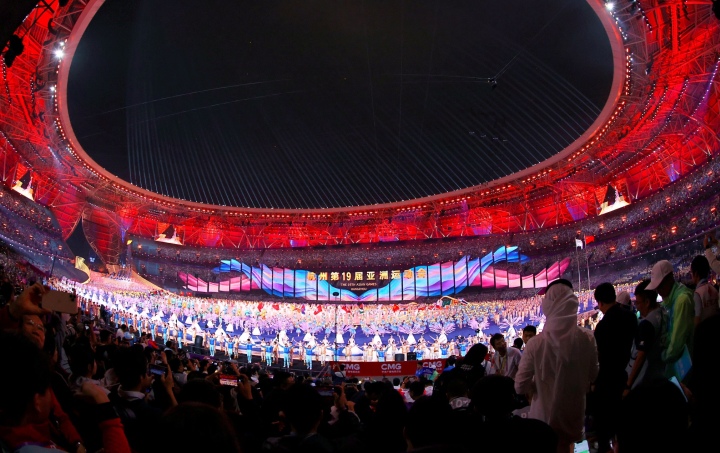
After a 13-year hiatus, chess is back to the 2023 Asian Games, which officially started on September 23, in Hangzhou, China, with a glittering opening ceremony. This return will give our game broad exposure in one of the world’s most dynamically developing parts. “Chess belongs to the family of mind sports that have a special place in the Olympic family. Currently, the International Olympic Committee doesn’t foresee chess to be included in the 2024 and 2028 Olympic games. But the development that we saw during the last few years with FIDE’s active participation gives us real hope that we will be able to include chess in Continental Games. Asian Games is one of such examples. Chess was an exhibition sport in the European Games and African Games. It is a part of the official program in some American Games, including the Central American and Caribbean Games, this year. It is a very good development. I hope that at some point a chess player will become an Olympic champion,” said FIDE President Arkady Dvorkovich in his exclusive interview with CGTN’s Liu Xin. The chess program of the 19th Asian Games features four competitions: men’s individual, women’s individual, and men’s and women’s team tournaments. The individual events with rapid time control run from September 24-27, while team competitions with classical time control will stretch from September 29 to October 7. The list of the countries-participants includes Bangladesh, China, India, Indonesia, Iran, Japan, Kazakhstan, Rep of Korea, Kuwait, Kyrgyzstan, Mongolia, Philippines, Qatar, Singapore, Sri Lanka, Chinese Taipei, Thailand, UAE, Uzbekistan and Vietnam. Many countries fielded their top players for this prestigious sports forum. We will see in action such strong and popular players as Hou Yifan, Tan Zhongyi, Zhu Jiner, Bu Xiangzhi, Wei Yi, Harika Dronavalli, Humpy Koneru, Gukesh D, Arjun Erigiasi, Vidit Gujarathi, Praggnanandhaa R, Pentala Harikrishna, Parham Maghsoudloo, Amin M. Tabatabaei, Zhansaya Abdumalik, Bibisara Assaubayeva, Dinara Saduakassova, and the winners of the 44th Chess Olympiad Nodirbek Abdusattorov, Javokhir Sindarov, Jakhongir Vakhidov, Shamsiddin Vokhidov and Nodirbek Yakkuboev. Photo: official website Official website: hangzhou2022.cn/
FIDE World Senior Team Championship: Day 5 recap
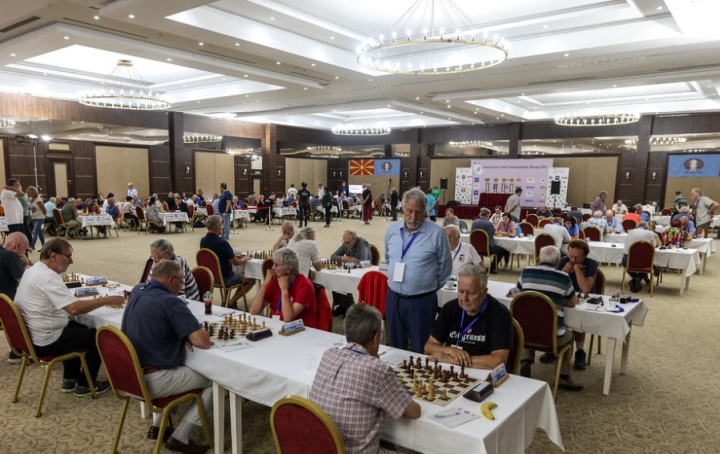
Iceland and USA are tied for the first place in the S50 section, closely followed by Italy; Germany Lasker Schachstiftung GK solely leads in the S65, with England 1, Slovakia and France trailing by two points. In the fifth round, we saw more draws than usual. Time will tell whether these were the result of match strategy, fatigue, or conservation of energy for the final rounds. The derby on the top board between USA and England 1 saw three relatively early draws. On board four, Davies (2354) had a very pleasant position with the black pieces against Novikov (2513) after successfully getting out of the opening in the Queen’s Gambit Declined with 4…a6. In the position where he offered a draw, Black was in no danger whatsoever and could have played on for a very long time. Black has a safe edge and can play on forever against White’s isolated pawn. The draw offer was surprising, especially as it was the only position where the English team could press without any risk. On board one, Adams (2662) offered a draw in a position that he didn’t really fancy, unlike the engine. The position was to Shabalov’s (2465) taste as Black was active on the kingside, but objectively, White had little to fear. Adams’s last move 19.Ra7 was a good one. Things are complicated, though, as after 19…Bc6 White needs to play 20.g3! Nh3 21.Kf1, with an advantage, but this is far from obvious. Black’s best is 19…Bd5, which leads to a messy position after 20.Rxd7 Qh6. So Adams made a practical decision to offer a draw, which was accepted. On board three Flear (2405) prepared the modern line with Bd2 in the Rubinstein Variation of the Nimzo-Indian against Ehlvest (2530) but didn’t achieve much. Ehlvest offered a draw on move 24 in an equal endgame. These draws meant that the fate of the match was in the hands of Kaidanov (2549) and Emms (2448). White won a pawn in the opening, but Black had good compensation for it. The game soon transposed to a theoretically drawn rook endgame. White played 29.Re5 in order to defend the pawn from the side with Re3. Emms defended well and successfully reduced the number of pawns on the kingside. Black waits now. White’s only try was to advance the pawn to b6 and then to try to capture the pawn on g4. On move 52, the critical position emerged on the board. Black now has a choice whether to play 52…Kg7 (in order to be ready for a possible b7) or to play 52…Rb4 first and then …Kg7. Unfortunately for Emms, after many hours of accurate defence, he made the wrong choice. The correct move was 52…Rb4! defending the pawn on g4 and only in case of 53.b7 playing 53…Kg7. Then the game and the match would have been drawn. After the mistake 52…Kg7? 53.Kxg4 Rxf2 54.Kg5, the position is won for White. White wants to transfer his king b7, but there is another threat – Rb7-c7 followed by b7, Rc8 and b8Q. Black tried to prevent the second threat and played 54…Rb2, but after 55.Rb7 Kf8 56.Kf6 The threat of mate meant that the black king needed to move. Going to g8 allows the white king to penetrate the queenside, but he could only postpone that as after 56…Ke8 57.Ke6, Kd8 fails to 58. Rb8 checkmate. Black started giving checks from behind, but the white king hid on b8 when the game was won with the elementary technique of building a bridge (the Lucena position). It was an incredibly important win for USA against one of the main competitors that allowed them to keep pace with Iceland, who also won their match. Iceland didn’t have much trouble with Montenegro. The draws on board one and four (Nikcevic (2358) – Olafsson (2491) and Thorallsson (2382) – Miljanic (2331), respectively, were from position of strength, while the Icelanders completely outplayed their opponents. A curious case happened on board three in the game Podlesnik (2289) – Arnason (2419). The game should have been drawn, but White blundered in the rook endgame and lost a couple of pawns. Then, unexpectedly, he was given a chance. Black’s last move 42…Rf5-e5 was a mistake, as the rook should have moved along the f-file to f2 or f1. Here, White should have played 43.Rd7! and the manoeuvre 43…Rh5-g5-g7 to defend the pawns doesn’t work in view of 46.Rd8 and White goes after the a7-pawn, with a drawn position. White missed this chance and played 43.a6? but after the simple 43…Re2 with the idea of …Ra2xa6 Black emerged two pawns up. On board two, Petursson (2396) defeated Pajkovic (2412) in convincing fashion. Italy continued their winning ways and beat Slovakia 3.5-0.5 with only Mrva (2361) managing a draw on board one against David (2523). Godena (2429) bested Motuz (2279) in spite of allowing an accidental drawing chance in a winning position that his opponent didn’t take, Ortega (2410) displayed exemplary technique against Dobrotka’s (2207) IQP and Borgo (2333) was superior in the complications after the opening against Kantorik (2195). The team North Macedonia Alkaloid beat Poland in a professional fashion. They had a huge rating advantage on board three, where Stanojoski (2351) faced Flis (1948) with the white pieces. So they left him to win the game while all the others drew without much fanfare: Georgiev (2542) drew Gdanski (2484), Nedev (2465) drew Sapis (2375), and Kutirov (2274) drew Masternak (2314). In the S65 section, the German team Germany Lasker Schachstiftung GK continued their excellent run, beating Israel 3-1. On board one Knaak (2438) defused an early attack and converted the extra pawn against Gruenfeld (2388), on board two Meister (2439) won a drawn double-rook endgame against Birnboim (2346) after the latter made two consecutive big mistakes. On board three, Kalintschew (2377) continued a winning streak in his unassuming way – this time Kagan (2244) managed to turn a completely harmless position on the white side of a Maroczy Bind into a lost one in several moves. On board four,
Carlsen denies Nakamura sixth straight Speed Chess title

GM Magnus Carlsen ended GM Hikaru Nakamura’s incredible run of five titles in a row with a thrilling 13.5-12.5 victory to clinch Chess.com’s flagship 2023 Speed Chess Championship Presented by Coinbase. The Norwegian got off to a strong, two-point start, but the ever-resourceful Nakamura fought to take a three-point lead in the 3+1 portion. After changing shirts, the former world champion evened the score just before the bullet section. Just as Carlsen started pulling away in the second half of the bullet, Nakamura won on demand. The latter was on the verge of winning the last game to tie the score but allowed an unforgettable double rook sacrifice that sealed the deal. Fans will not wait long to see this pairing again. They two speed demons are paired on the first day of the Champions Chess Tour AI Cup 2023 which starts on Monday at 12 p.m. ET / 18:00 CEST / 9:30 p.m. IST. This was far from their first Final in the SCC—it was their fourth. Carlsen led their encounters 2-1, but Nakamura won his first in 2022. That match went down to the wire and was decided in the very last bullet game too, where Carlsen was a hair’s length from reaching overtime. Nakamura celebrated his victory while down two queens as the match clock expired. Going into this year’s match, Carlsen led their head-to-head encounters on Chess.com in both bullet and blitz time controls. He was clearly the statistical favorite, but we have seen reality take its own form time and time again. SmarterChess agreed, showing a slight preference for Carlsen’s chances. While it estimated their chances to be equal in the 5+1 and 1+1, it forecasted Carlsen’s edge to lie in the second portion. Curiously, that was the one segment he didn’t win. “This is as good as it gets. Speed chess matches between Hikaru and I, be that blitz, or rapid, or even bullet, that’s as good a show as it gets,” said Carlsen after last year’s exhilarating Final. And this year only raised the bar again. 5+1: Nakamura 4-5 Carlsen The first half of this portion was the calm before the storm. In the first five games, Carlsen scored one victory and four games were drawn. The last four, on the other hand, were all decisive. Carlsen took the first full point in game two, a Ruy Lopez Berlin Defense that took on the shape of a Benoni Defense. The world number-one hit his rival with the ol’ “sealer sweeper” sacrifice, 27.e5! followed by 28.f5, and closed out the game with a satisfying blow 32.Rxe7!, winning a piece. 1-0 The next three games ended in draws. But on the other side of that equilibrium, the games were decisive at every turn. Carlsen took a two-point lead after finding a tricky resource, 51.d6!, in mutual time trouble. But Nakamura proved his resilience as well, bouncing back in the next by winning the objectively drawn rook and bishop vs. rook endgame. Carlsen won the next after firing the cannonball 21.Bxh6! followed by a winning attack. The last game of the match was nervy and explosive. Both players were winning at various points, although the psychological trend was certainly in Nakamura’s favor for most of it. In mutual time trouble, the American GM prevailed. 3+1: Nakamura 5-4 Carlsen Before this year, Carlsen had never lost a 3+1 portion against Nakamura in the SCC. It was a great start for the five-time SCC champ as he scored four wins in the first five games. At the halfway mark, Carlsen changed shirts and, when he returned, evened the score. Nakamura played a gorgeous attack in the first game, finishing it with a lustrous queen sacrifice on the last move, 24…Qxg3!!. This would have been our Game of the Day had it not been for the last game of the match. Nakamura won with an attack just as crushing in the next game. Suddenly, he led the match for the first time. After a draw, he won two more. Both were defensible endgames where Carlsen, with almost no time, collapsed. The first one was a rook endgame, and the second featured a piece sacrifice by Nakamura for two connected passers. “This was the most unbelievable endgame yet,” said Naroditsky about the second, while Hambleton added: “Have you ever seen a mic drop in chess? This was one of them.” Nakamura stood up emphatically and walked away as Carlsen remained in his chair looking at what went wrong. “Carlsen” and “losing equal endgames” are frankly never uttered in the same sentence, unless the latter refers to his opponent. Carlsen returned from the half-point break wearing a new shirt, the same one he had worn when he beat So on Tuesday. It seemed to work as he won two consecutive games. Then a draw. And, finally, came the last game of the segment, where he pulled the vintage Magnus endgame squeeze to tie the score. Carlsen, when asked whether changing shirts helped, responded in the post-match interview: “The result sort of speaks for itself.” The score was 9-9. One half-hour left. The stage was set for drama, and the players delivered. 1+1: Nakamura 3.5-4.5 Carlsen The only other SCC Final tied at the end of 3+1 portion was Nakamura vs. So, 2018, which was tied at 10-10. Nakamura went on to win in the bullet. In this one, Carlsen had a lousy start; then he picked up speed. The first game was a terrifying one for Carlsen fans as he hallucinated and gifted his opponent a queen. He would later say: “I did feel that from last year and the Bullet [Chess] Championship this year, that I know I could come back from a reasonable deficit. So I knew that it was all about whether my brain could start working.” And start working it did. He won three of the next four games. First, it was a same-colored bishop endgame, then a razor-sharp heavy-piece endgame, and finally, a conversion of two pigs on the seventh.Carlsen led by two. But Nakamura won on demand after Carlsen’s clever but
FIDE World Senior Team Championship: Day 4 recap
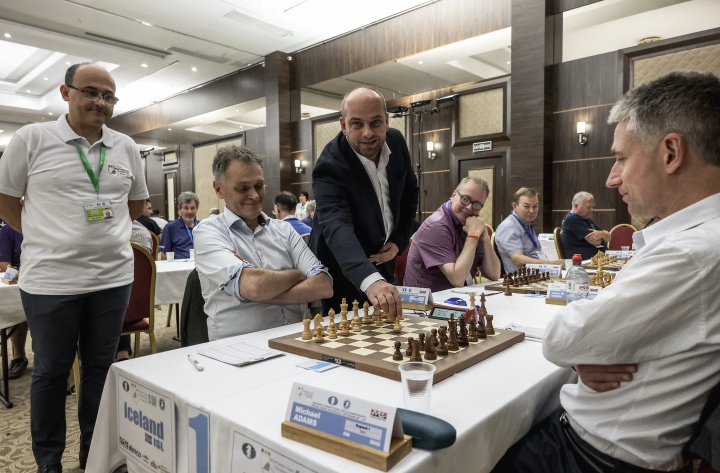
The fourth round saw tense matches and exciting turnarounds in the duels of the favourites. Two teams with the perfect score 6/6, Iceland and England 1, clashed in the central match of the day in the S50 category. The English players didn’t pose serious problems with the white pieces, as Emms (2448) couldn’t create anything against Hjartarson’s (2432) French Defence, and Arkell (2352) was similarly toothless against Thorallsson (2382). All the action happened on the odd-numbered boards. Facing Olafsson (2491) with Black, Adams (2662) chose an old favourite of his, the Queen’s Indian. The opening went surprisingly well for Black, and soon enough, he started to think about being better. Black jumped 16…Nc3 and after 17.Bxc3 dxc3, the pawn on c3 became a dangerous asset, especially as it could be supported by …Bf6. Both sides placed their pieces on natural squares, and on move 21, White embarked on a strange-looking manoeuvre. In view of White’s last move 20.h4, Adams expected 21.Ng5 here, with ideas like Qh5 or Nge4, but instead of that White played 21.Bh3 with the idea of Bf5-b1! The plan was to control both a2 and c2 in view of the impeding …Nb4, but Adams already felt that this wasn’t quite right for White. The critical moment came on move 25. Adams expected the exchange of rooks on d8. Black should still be winning, but it would have been more difficult than in the game. White played 25.Bd3? and after 25…Nb4 was forced to go back 26.Bb1, which obviously only helped Black. After 26…Qg4 White’s position collapsed, and he resigned after 27.Re1 Bxc4 28.bxc4 c2 as Black wins material. During the post-game interview on the live broadcast, Adams showed a fantastic line, which, although far from forcing or even very relevant, I have to show. Michael calculated this during the game, though he realised White’s last move 29.Qd6? was bad (better was 29.Nd6). But here he was quite happy to find 29…Qxf3!! 30.Kxf3 Nd4 31.Kf4 Nd2 mate! A position that deserves a diagram! Unfortunately for the English team, on board three, Flear (2405) couldn’t withstand the pressure in spite of defending well for some time against Petursson (2396). Here, the only move was to exchange queens by 28…Rxd4 29.Rxc7 Ra4, though White is certainly still better. However, the retreat 28…Qc8? lost on the spot in view of 29.Qd6 and after 29…Be8 30.Bxe5 fxe5 31.Qe7 Black resigned as mate will soon follow, even if he gives up a piece to postpone it. USA were very lucky to beat England 2, and for that, they had to thank Shabalov’s magic on board one. Shabalov’s (2465) attack was finely repulsed by Dishman (2304) who obtained a winning position. The price he had to pay was time-trouble. It was here that Shabalov used all his imagination to sow chaos on the board. By that point, the position became unclear and a total mess, with both players making. The best for White would have been 32.Rfd1, but instead of that, Shabalov took the pawn with 32.Rxf5. Here Black was winning with 32…Rc4!, although 32…Rxg2 and 32…Nd4 were also tempting, though not winning. In severe time scramble, Black simply blundered the pawn on f6 with 32…Ne7?? and after 33.Qxf6 White won. Before this win, USA was leading 2-1 thanks to a technical win by Novikov (2513) against Clark (2278). Black sacrificed a pawn as early as move 4 (!) in the Grunfeld. Instead of the usual 4…Nxd5, Black played the surprising 4…c6!? and obtained some compensation for the pawn after 5.dxc6 Nxc6 6.e3 e5, but didn’t make the most of it. White consolidated and converted the extra pawn. The games on boards two and four between Lewis (2238) and Kaidanov (2549) and Stebbings (2257) and Yermolinsky (2419) respectively, ended in calm draws. The match between Italy and North Macedonia Alkaloid saw incredible twists and turns. The first game to finish was David (2523) – Georgiev (2542) where Black masterfully outplayed his opponent. Black risks ending up in a passive position, and after a long thought Georgiev came up with what he called “the only move” 14…f5! Black must create activity and inject dynamism into the position. Over the next several moves, Black gave up the bishop pair to wreck White’s structure by taking on c3, making all White’s pawns isolated. The key moment was on move 20, when Black found a wonderful manoeuvre. After 20…Nd8! Black achieves beautiful harmony – the knight defends both weaknesses on e6 and b7, and Black threatens …Bc6 to exchange the defender of the white king. White’s situation was compounded by the severe time-trouble that he entered. David resisted but still blundered in the end. White’s last move was a mistake, though his position was not one to be envied. Black wrapped up with the cute 28…Rg3+! This win gave the Macedonian team the early lead. They had great positions on the remaining three boards as well. However… Thanks to his good preparation Nedev (2465) achieved an advantage both on the board and on the clock against Godena (2429). Here, White should have played 21.Rxe5 Nd7 22.Re7 Nxb6 23.Rxb7 Nxa4 24.Bxc4, but instead of that, he blundered with 21.Bc7? After 21…Nd7! the tables suddenly turned around – Black consolidated his position, and the bishop on a2 and White’s pawns became easy prey. Although Black had only a couple of minutes to reach time control, he was up to the task and scored a full point. On board three, again, thanks to very good preparation, Bogdanovski (2385) obtained a better position with Black against Ortega (2410) in the Exchange Variation of the Slav. He correctly avoided a move repetition that White was seeking but faltered at the critical moment. Instead of finally getting rid of the backward pawn with 24…c5!, with a clear advantage, Black played 25…Bb5? and allowed White to take a grip on the c5-square with 26.Nb3. The position was equal and continued to be so for a while before Black committed a horrendous blunder. Black’s last move was 35…Kd6?? (any rook move would have kept the balance) and White struck with 36.Nxa6! winning a pawn. The conversion wasn’t very difficult for Ortega. On board four Stanojoski (2351) got a small edge against Bellia (2388), but that
FIDE World Junior Championship U20 starts in Mexico City

The President of the National Chess Federation of Mexico, Dr. Mario Antonio Ramírez Barajas, together with representatives of the Mexican Government, special guests and representatives of FIDE, inaugurated the U20 World Junior Chess Championship. The multiple delegations arriving in Mexico City, received the welcoming words of President Mario Ramirez Barajas, President of the National Chess Federation of Mexico. He was joined in the praesidium by the four-time World Women’s Champion Susan Polgar, Erik del Angel Landeros, Coordinator of Technical Council for Diplomacy and Sports Cooperation of the Ministry of Foreign Affairs, Martin Bermudez, Director of the Mexican Olympic Committee, Luis Cámara Patrón, organizer of the “Copa Cámara y Asociados”, Amalia Galvan Trejo, Homero Fernandez Pedroza Director of the Cultural Complex Los Pinos, Carolina Muñoz, Chief Arbiter, Klara Kovac, member of the Fair Play Panel, and Allan Herbert, President of the Appeal Committee. The opening ceremony featured a mariachi music performance, accompanied by a talented folk dance group that did regional dances of Guadalajara, such as the “Son de la Negra” and the famous “Jarabe Tapatío”. “This world-class tournament is very meaningful for all participants of all levels. It is an opportunity and a privilege for Latin America to have a competition of this magnitude in Mexico; it is a sign of confidence and a boost that we must take advantage of to develop our technical level,” said President Mario Ramirez about the importance of this tournament. “We are now watching the future players of the world’s elite. The youngsters who will replace Magnus Carlsen, Hikaru Nakamura and that great group of top players, are in this tournament today. This is a very important additional value for the purposes of the event,” he added. For her part, Susan Polgar added some welcome words, and the event was officially open. It was followed by the ceremony of the Ignition of the Aztec Fire, granted by the Pre-Hispanic Dance Group through a cauldron and a dance. The ceremony, a pact celebrated by the Gods to give life to this world in relation to the position opposite to the first step of the sun through the zenith, symbolized the balance and order of the universe. With the ceremony concluded, President Mario Ramirez invited the players to receive the presents the Organizing Committee had prepared for them. After the opening ceremony, the organizing committee drew the colours and determined the pairings. The top-rated participants, GMs Hans Niemann and IM Carissa Yip, both from the United States, took part in the drawing lots by choosing a Mexican charro who had a white or black piece on their hats. Both top-seed picked the white pieces. Official website: juniorchampionship2023.fide.com Regulations and invitation letter (pdf) Photos: David Llada
FIDE World Senior Team Championship: Day 3 recap
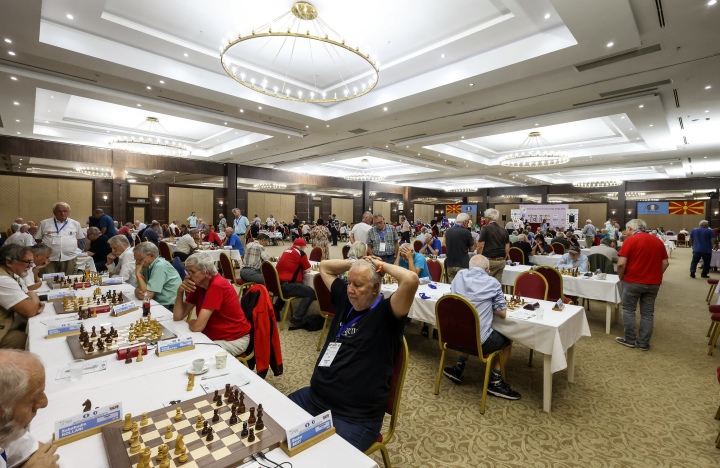
The third round of the FIDE World Senior Team Championship saw the expected clashes of the favourites, and these duels did not disappoint. The top match between North Macedonia Alkaloid and USA started slowly. Georgiev (2542) didn’t achieve anything out of the opening against Kaidanov (2549), and after the latter’s precise execution of the simplifications, a draw was agreed on move 32. The slow start was compensated by the storm on board two in the game between Ehlvest (2530) and Nedev (2465). In the Rossolimo Scicilian, Ehlvest based his preparation on the recent online game between So and Carlsen, but Nedev deviated from Carlsen’s play, and it seemingly caught White by surprise. Soon enough, both players were spending a lot of time calculating and the first critical moment arose on move 12. Instead of the simpler (and superior) 12.Qxd3, Ehlvest got tempted by the attractive 12.e6!? which after 12…fxe6 opened the f-file and prevented Black from castling. However, after 13.Qxd3 b5 14.Bc2 Qh4! it’s amazing how quickly Black’s pieces swarmed the kingside. Black’s next moves were 15…Ne5 (attacking the queen) and 16…Ng4 (threatening mate on h2) and then suddenly, he was creating a mating attack with three pieces. In this position, White had to make a crucial choice. As indicated by Nedev in the live broadcast, the best was to play 17.Nf3 and Black doesn’t have anything more than a perpetual in case of 17…Nf2 18.Kg1 Ng4, or if he wants to continue the game, 17…Qh5 18.h3, leads to an unclear position – here, White’s king is not as weakened as in the game. Ehlvest opted for 17.g3? which was a bad practical choice – the weakness of the white king became a decisive factor. After 17…Qh3 18.Rf4? was another ambitious but wrong move. The same Nf3 mentioned earlier would have limited the damage. After 18…h5 Black was already winning! White has no defence against numerous threats such as …g5, …Bb7, …h4 and …hxg3. The execution was swift. After 19.e5 g5 20.Rf3 h4! White could have resigned as either …hxg3 or …Bb7 was coming. The final position, three moves later, perfectly illustrate the disaster that struck White. Ehlvest resigned. 0-1 It was a flying start for the Macedonian team. On board three, Bogdanovski (2385) had an initiative in the opening against Novikov (2513) but didn’t play precisely, so the game fizzled out to a draw. More drama unfolded on board four. Stanojoski (2351) improvised in the opening against Yermolinsky (2419) and ended up with a knight on the rim and in a bad position. White obtained a dream Catalan position, and in search of complications, Black played 13…Ng4 14.Na4 Bxf2, which was far from even remotely adequate. After 15. Rxf2 Nxf2 16.Kxf2 White was already winning. White quickly consolidated with Be3 and Nc3, while the knight was still stuck on a6. Then the game continued normally, with White even winning the pawn on a7 as Black threw caution to the wind and concentrated on the kingside. The dramatic moment came on move 29. White wasn’t very precise, but he should still win after 29.Rxe5. However, Yermolinsky quickly played his intended 29.h4?? Stanojoski spent two-and-a-half minutes on his move and missed the winning 29…Rxf3! which turns the tables completely. The rook is taboo in view of 30.Bxf3 Nh3, while if the queen escapes, Black plays …Rg3 and …f3 with an easy win. It’s curious that Yermolinsky missed the blow on f3 completely and only found out about it when I told him during the live broadcast! Black took on a3 instead of f3 and after 30.hxg5 White was winning again. There were no more chances for Black in the remainder of the game. The tense match ended 2-2, perhaps a fair result, but these kinds of chances must be taken if a team wants to win an event. On the other hand, it may be a good omen for the Americans, as luck was clearly on their side. England beat Italy 2.5-1.5 thanks to a win by Adams (2662) against David (2523). Adams prepared a recent, but still rare, line against the Taimanov, and the surprised David decided to sacrifice a pawn in search of compensation. Black obtained it, but in the critical moment, he wasn’t up to the challenge. White’s last move was 28.Bf4, preparing g3 or g4. Here Black’s best move was 28…Rh4! preventing 29.g4 in view of 29…Rxg4! 30.Nxg4 Rxg4 31.Kf1 Bg5 and Black regains the material. Perhaps David was worried about 29.g3 but in this case he has 29…f5! (if this is too complicated, the immediate 29…Rxf4 30.Rxf4 Ne2 was a back-up option) 30.exf6 Rxf4! 31.Rxf4 Ne2 32.Kf1 Nxf4 33.gxf4 Bxf6 with a relatively easy draw as White’s pawns on the f-file are weak. Not easy, but to make a draw against a world-class player like Adams, one has to navigate such calculations. David played 28…Rgh8? but after 29.g4, he didn’t have any compensation, and Adams won convincingly. The Italians missed their chance on board four, where Borgo (2333) got a winning advantage against Arkell (2352) after the latter over-extended his position. But the Italian misplayed it and allowed his opponent to simplify the position and draw. The other two games were drawn. Emms (2448) showed excellent preparation to neutralise Godena’s (2429) Alapin Sicilian, while Ortega (2410) defended with precision to extinguish Flear’s (2405) initiative. England is tied for the top position with Iceland that whitewashed Austria. In the S65 section, only two teams managed to keep their 100% score. Germany Lasker Schachstiftung GK ended the dream run of North Macedonia after beating them 3-1. Wins with the white pieces on boards two and four were enough for a convincing win. Meister (2439) maneuvered patiently against Kralevski (2054) in a position where he had two bishops and a queen against a bishop, knight and a queen. Maneuvering is not Kralevski’s strong side and he was gradually outplayed. On board four Trajkovski (1947) badly misplayed the English Opening against Koehler (2189) and couldn’t come back after that. The draw on board one between Ilic (2044) and Knaak (2438) came as a result of mutually cautious play, but on board three Stosevski (1968)
World Youth Chess Championship 2023: Registration deadline extended

The Organizing Committee announces that the registration deadline for the participants of the World Youth Chess Championship U14, U16, U18 2023 has been extended to September 30, 2023. The competition will take place in Montesilvano, Italy, from November 12 (arrivals) to November 25, 2023 (departures). FIDE member Federations can register one official player in each category (U14, U16, U18, open and girls). The organizers invite six official players and one accompanying person (captain/trainer) from each federation according to the Handbook. The players placed 1-3 in the previous U14, U16, U18 World Youth Championships, and the respective Champions of the last Continental Youth Championships, will have the personal right to participate in the corresponding age category. Invitation letter and regulations (pdf) FIDE World Youth Chess Championships 2023 official website E-mail: worldyouth2023@fide.com Photos: FIDE World Youth Chess Championships 2023 official website
FIDE World Senior Team Championship: Day 2 recap

In the second round, the favourites continued to win their matches, but the resistance was visibly stiffer. One wonders, if the matches are tough so early, what would happen in the final rounds? In the S50 section USA beat Montenegro 3.5-0.5, but the match was closer than the scoreboard would suggest. The draw on board one was a result of a good defence by Nikcevic (2358) against Shabalov (2465). On board two, Pajkovic (2412) had a normal position with White in a reversed Benoni, but he misevaluated opening of the b-file, which was not forced at all, and it turned out to be in Black’s favour. On board three, Ehlvest (2530) sacrificed a pawn for a dangerous attack against Podlesnik (2289), but Black defended with great precision to maintain balance. However, in a tense position, both players blundered: Black’s last move 25…Be4? was a mistake. The only continuation to keep the game going was 25…f4. But here, inexplicably, Ehlvest didn’t play the obvious 26.Qg5, when an inevitable mate comes after Bg7 (or even the cheeky Qg7) and opted for the flashy 26.Rg6, which allowed Black to play a pretty defensive queen sacrifice with 26…Rxe7! 27.Rxe6 Rxe6, which led to an unclear situation. In fact, the position became easier to play with Black. However, instead of consolidating, which would have given him easier play and an advantage, Podlesnik continued aggressively, only to become the unfortunate player who blundered last. Here, Black should have taken on g2 with check and then captured the d6-pawn, with a tense but objectively equal position. But Black miscalculated and played 33…Bxg2?? but missed that after 34.Qxe6 Bd5 White has 35.Qxg8! winning on the spot. After Black captured the queen, White pushed d7 and won the game. 1-0 On board four, Novikov (25143) displayed good technique to overcome Miljanic (2331). England beat Poland 3-1, but they had a lucky break early on when Flear (2405) won quickly, thanks to a swift and unexpected attack against Sielicki (1956). Black sacrificed a pawn for the initiative, and here he broke through with 27…f4! After 28.exf4 Nf5 Black wrapped up in style with …Nxf2 next. 0-1 The second win for England came on board one, where Adams (2662) outplayed Gdanski (2484) from the black side of the Exchange Ruy Lopez. It was a typical Adams game where it was almost impossible to sense the moment the position started shifting from equal to a somewhat more pleasant for Black to winning for Black. There was a curious situation at the end of that game. Adams is completely winning; the question is how to do it. Instead of calculating the pawn endgame after the exchange of rooks followed by …b5, which also wins, Adams played 52…Rf4, grabbing a second pawn, forcing an immediate resignation. For those readers who might think that this was a senior moment, I hasten to say that Adams’s decision was the more practical one – why calculate when you can win without calculation? This approach has been recommended by many coaches, including Mark Dvoretsky. The other two games were drawn, even though both Emms (2448) was pressing against Sapis (2375) and Davies (2354) was doing the same against Flis (1948). Italy beat England 2 thanks to David’s (2523) win over Dishman (2304) on board one. All the other games were drawn, giving Italy a narrow win. Black’s king won’t survive, and White is spoilt for choice of winning moves (22.Rac1 and 22.Nxf7), but David went for the spectacular 22.Nxe6! Kxe6 23.Qg7 and eventually the black king was mated on b5. The home team of North Macedonia Alkaloid also won narrowly, but at least they were never in danger of losing the match. The only win happened on board one when, in a severe time trouble, Mrva (2361) forgot about his rook against Georgiev (2542). Black (Georgiev) has an extra pawn, but White has obvious counterplay on the kingside, thanks to the very stable bishop on d3. Now, White could have taken on g6 or played 38.Re7, when Georgiev wasn’t sure about the position – in fact, it is objectively equal. However, White played 38.Qf4?? and after 38…Rb4! could resign as the black rook moved away from the attack with tempo, something the rook on e1 couldn’t do. Black won the exchange and the game. 0-1 The other games were drawn, but Bogdanovski (2385), on board two, missed a one-move win against Motuz (2279). White was winning from the early middlegame, being a pawn up for nothing. With his last move, Black took on a2 and here instead of the obvious 31.Ra1, winning a piece in view of the mate on a8 (or because of a pin after 31…Ra7 32.Bd5), he played 31.Rxc5? and then couldn’t convert the extra pawn. In the S65 section, both Germany Lasker Schachstiftung GK and England 1 won 3-1. The German team had a wild game on board one where a technically winning position for Knaak (2438) against Westerinen (2237) became a complete mess after White misplayed it. White was a pawn up and dominating for a long time, and here he went for the pretty 35.Qxf8! Kxf8 36.Kf1 (36.a7 was even stronger), which should have won. But he misplayed the position completely, and soon enough, it was Black who was winning! Here 46…Qd8, 46…Qf6 and 46…Qc1 were all winning for Black, but he played 46…Ne7, and it was equal again. After many twists and turns, Black refused to give up his bishop for the a-pawn to stop promotion, and White eventually won. Nunn (2569) beat Sadiku (2143), and Kosten (2352) outplayed Xheladini (2149) to ensure England’s victory over Kosovo, as the other two games were drawn. The surprise winners were again the hosts North Macedonia, who beat Austria 1 by 2.5-1.5 after Kralevski (2054) on board two bested Danner (1967) with all the other games being drawn. North Macedonia shares first place with two wins together with four more teams. Tomorrow we will see several clashes of favorites, and it’s only Round 3! Standings after Round 2 S50 Standings after Round 2 S65 Round 3 starts tomorrow at 3 pm local time. Written by GM Alex Colovic Photos: Mark Livshitz Official website: seniorteam2023.fide.com/
Intercontinental Online Chess Championship for Prisoners: Registration deadline extended

A record number of participants – 88 teams representing 41 countries have already registered for the third Intercontinental Online Chess Championship for Prisoners, scheduled for October 11-13, 2023. Teams wanting to join the tournament can register via the following link until September 29, 2023. 57 male, 18 female and 11 youth teams made of amateur chess players, for whom the game became not just a hobby but a strong motivation to change for the better, will be representing correctional facilities from Argentina, Australia, Bulgaria, Colombia, Croatia, Czech Republic, Ecuador, England, Ghana, Georgia, Germany, Greece, Grenada, India, Iran, Ireland, Italy, Jamaica, Jersey, Kyrgyzstan, Latvia, Malawi, Mexico, Mongolia, Montenegro, North Macedonia, Norway, Paraguay, Philippines, Portugal, Romania, El Salvador, Serbia, Slovenia, Spain, Switzerland, Trinidad and Tobago, Turks and Caicos, UAE, USA, and Zimbabwe. For most of them, this international tournament is an opportunity to test their chess skills acquired in the classes within the prison walls and while playing the game with the inmates. The number of countries and correctional facilities implementing the Chess in Prisons program is constantly growing. The English Chess Federation has been running a program supporting chess in prisons since 2014. A chess player, author, and columnist, Carl Portman, who volunteers for the Chess in Prisons program in the country, has visited a number of prisons across the country. Carl provides valuable support to prison communities, where it is recognised as a purposeful activity for inmates, supporting the development of critical analysis and reasoning skills and helping to reduce reoffending rates. “As the chess columnist for the prison newspaper ‘Inside Time’, I receive a large amount of posts from inmates, and I use that feedback to measure how chess features in prisons. As one inmate wrote, ‘It has taught me to think ahead and not make rash decisions.’ My motto for life has always been ‘Don’t complain about the darkness, light a few candles’,” says Carl Portman. The reigning champions of the Championship for Prisoners, who won the event in October 2022, are the Philippines in the male section, Mongolia in the women’s category, and Serbia in the youth tournament. Jail officer 1 Cedrix B Cabangal, representing the General Santos City Jail in South Cotabato, Philippines, winners of the 2022 event, has served as a team coach since 2021, when the first tournament took place. “In 2021, I saw a post on FIDE’s website about the international tournament among prisons, and I immediately signed up. This year, we are joining again and are determined to retain our champions’ title,” he says. Participation in the tournament is free of charge. It is open for teams made of 4 players representing any correctional facility (jail or prison). Winners will be determined in male, female and youth categories. Tournament regulations More info about the program can be found here: chessforfreedom.fide.com
FIDE celebrates its centenary anniversary with a series of key events
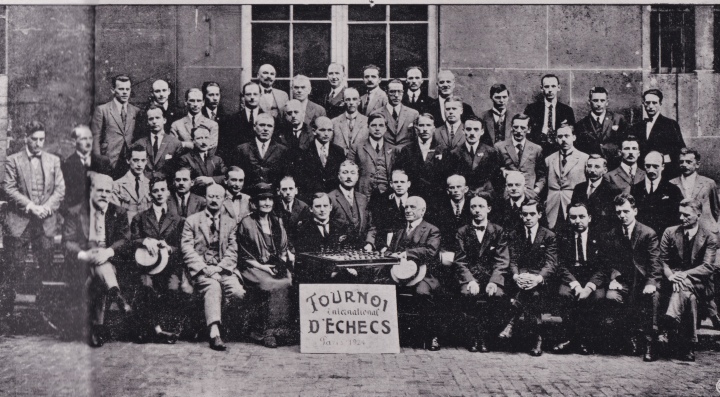
In 2024, the International Chess Federation (FIDE) celebrates its centenary anniversary. FIDE was formed on July 20, 1924, in Paris, France, at the Town Hall of the IX Arrondissement of Paris (6 Rue Drouot) during the first unofficial Chess Olympiad. Fifteen delegates from all over the world signed the Proclamation Act, and our organization was born. “A beginning has been made, the foundation laid, and the prospects are fairly good that we shall soon have a working organization, the aim of which will be, in a measure, to bring order out of chaos and to have a central authority, one of the chief aims of which will be the bringing together in international congresses lovers of the game from far distant points of the earth,” wrote the American Chess Bulletin in November 1924. As part of the celebrations throughout the year 2024, FIDE is planning numerous activities, including chess festivals, exhibitions displaying historical archives, documents and chess memorabilia, FIDE 100-year Jubilee Book by Willy Iclicki, Chair of the FIDE Historical Committee, tournaments organized all around the world, online chess museum with rare chess photos, unique publications about FIDE, posters from major events of the past, and many others. In February 2024, the Chess Torch Relay will start with the grand opening in India, the birth country of chess and the host of the 44th Chess Olympiad. It will cross the continents and finish in Budapest, Hungary, the city of the 45th FIDE Chess Olympiad. On July 20, 2024, the International Chess Day, FIDE will also attempt to set a World Guinness Record with the biggest number of chess games played in a day. The events organized to celebrate FIDE Centenary Year will culminate with a special gala in Paris, the city of FIDE’s birth. “Founded in 1924 under the motto “Gens una Sumus”, FIDE is one of the very first International Sports Federations. It is a consequence and driving force of the worldwide popularity of chess, and we want to share the brightest moments of our history and the history of our beloved game with people all around the world. The Chess Torch Relay will start in India, the country where chess was born and from where it has spread around the world and become a global game the whole world plays with enthusiasm. Chess Olympiad in Budapest that will bring together all the chess nations will also be used as the highlight spot for celebrations with anniversary awards, seminars and exhibitions,” says FIDE President Arkady Dvorkovich. The first of a series of events to mark this historic occasion will start on September 23. The countdown will begin 100 days before 1924 on FIDE social media. One hundred posts, one per day, will be published. Each post, marked with the #FIDE100 hashtag, will tell about a significant event in the history of FIDE that happened that year, starting from 1924. Our social media followers will learn when the first Chess Olympiad was organized (1927), FIDE started overseeing the World Chess Championship (1948), the first Grandmaster titles were awarded (1950), the official FIDE rating list came out (1971), FIDE was recognized by the International Olympic Committee (1999), and many other major milestones in the organization’s history. “The International Chess Federation has come a long way since its first steps a century ago. Throughout its history, FIDE has been instrumental in shaping the world of chess, and we never stop aiming for new heights, serving the game and chess community,” says Dana Reizniece-Ozola, Deputy Chair of the FIDE Management Board. We encourage all the organizers and federations to plan their regular and special events under the umbrella of #FIDE100. We are also seeking support from the chess community to rebuild the FIDE historical archive by sending us photographs, documents, videos, memorabilia, bulletins, and other chess items related to the history of FIDE and the development of chess. Please feel free to contact Willy Iclicki and send photos of your chess memorabilia to centenary@fide.com. All contributors will receive proper recognition, while FIDE would also consider offering retribution for especially valuable items. Let us make the FIDE centenary celebrations really big! The game is just beginning!

